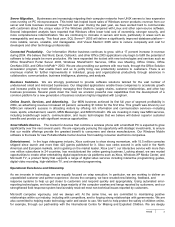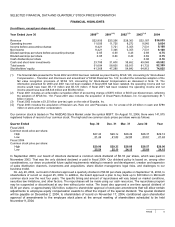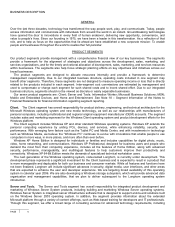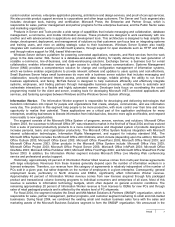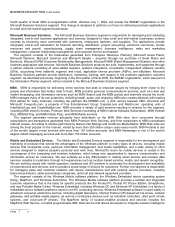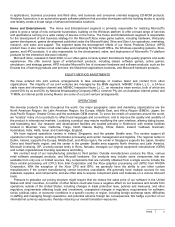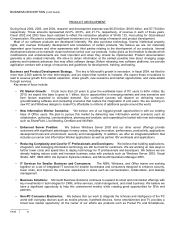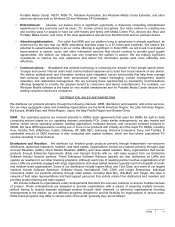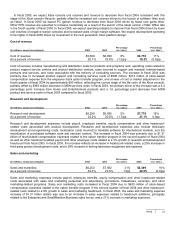Microsoft 2004 Annual Report Download - page 13
Download and view the complete annual report
Please find page 13 of the 2004 Microsoft annual report below. You can navigate through the pages in the report by either clicking on the pages listed below, or by using the keyword search tool below to find specific information within the annual report.
PAGE 13
means that future versions must deliver significant additional value in order to induce existing customers to purchase a
new version of our product.
Our competitive position may be adversely affected in the future by one or more of the factors described in this section,
or as yet undefined additional factors that may arise.
Client. Although we are the leader in PC operating system software products, we face strong competition from well-
established companies and entities with differing approaches to the market. Competing commercial software products,
including variants of Unix, are supplied by competitors such as IBM, Hewlett-Packard, Apple Computer, Sun
Microsystems and others, which are vertically integrated in both software development and hardware manufacturing and
have developed operating systems that they preinstall on their own computers. Personal computer OEMs who preinstall
third-party operating systems may also license these firms’ operating systems. The Linux operating system, which is also
derived from Unix and is available without payment under a General Public License, has gained increasing acceptance as
competitive pressures lead personal computer OEMs to reduce costs. The Microsoft Windows operating systems also
face competition from alternative platforms, as well as innovative devices that may reduce consumer demand for
traditional personal computers. We believe our operating system products compete effectively by delivering better
innovation, an easy-to-use interface, compatibility with a broad range of hardware and software applications, and the
largest support network for any operating system.
Server and Tools. Our server operating system products face intense competition from a wide variety of competing
server operating systems and server applications, offered by firms with a variety of market approaches. Vertically
integrated computer manufacturers such as IBM, Hewlett-Packard, Sun Microsystems and others offer their own variant of
Unix preinstalled on server hardware, and nearly all computer manufacturers offer server hardware for the Linux operating
system. IBM’s endorsement of Linux has accelerated its acceptance as an alternative to both traditional Unix and
Windows server operating systems. Linux’s competitive position has also benefited from the large number of compatible
applications now produced by many leading commercial software developers as well as non-commercial software
developers. A number of companies supply versions of Linux, including Novell and Red Hat.
We compete in the business of providing enterprise-wide computing solutions with several companies that provide
competing solutions as well as middleware technology platforms. IBM and Sun Microsystems lead a group of companies
focused on the Java 2 Platform Enterprise Edition (J2EE). Commercial software developers that provide competing server
applications for the PC-based distributed client/server environments include Oracle, IBM, and Computer Associates.
There are also a number of non-commercial software server applications available.
Numerous commercial software vendors offer competing commercial software applications for connectivity (both
Internet and intranet), security, hosting, and e-business servers. Additionally, IBM has a large installed base of Lotus
Notes and cc:Mail, both of which compete with our collaboration and e-mail products. There are also a significant number
of non-commercial software products that compete with our solutions, including Apache Web Server.
Our developer products compete against offerings from BEA Systems, Borland, IBM, Macromedia, Oracle, Sun
Microsystems, and other companies.
We believe that our server products provide customers with significant advantages in innovation, performance (both
relative to total costs of ownership and in absolute terms), productivity, applications development tools and environment,
compatibility with a broad base of hardware and software applications, security, and manageability.
Information Worker. While we are the leader in business productivity software applications for personal computers,
competitors to the Microsoft Office System include many software application vendors such as Apple, Corel, IBM, Oracle,
Sun Microsystems, and local application developers in Europe and Asia. IBM and Corel have significant installed bases
with their office productivity products, and both have aggressive pricing strategies. Also, Apple and IBM preinstall certain
of their application software products on various models of their PCs, competing directly with our applications. Corel’s
suite and Sun Microsystems’ Star Office are aggressively priced and attractive for OEMs to preinstall on low-priced PCs.
The OpenOffice.org project provides a freely downloadable cross-platform application that is gaining popularity in certain
market segments. In addition to traditional client-side applications, Web-based offerings such as SimDesk provide an
alternative to Microsoft Office System products. In addition, IBM has a significant installed base of messaging and
collaboration software. We believe that our products compete effectively by providing customers significant benefits, such
as ease of use, personal productivity, support for effective teaming and collaboration, and better information management
and control, and by providing many customers a lower total cost of ownership than alternatives.
Microsoft Business Solutions. The small and mid-market business applications segment is highly fragmented and is
intensely competitive in all sectors where we compete. We face competition from a large number of companies in this
business. Well-known vendors focused on small and mid-market business solutions, such as Intuit and Sage (along with
many others), compete against us for a portion of this segment. In addition, large-enterprise focused vendors, such as


